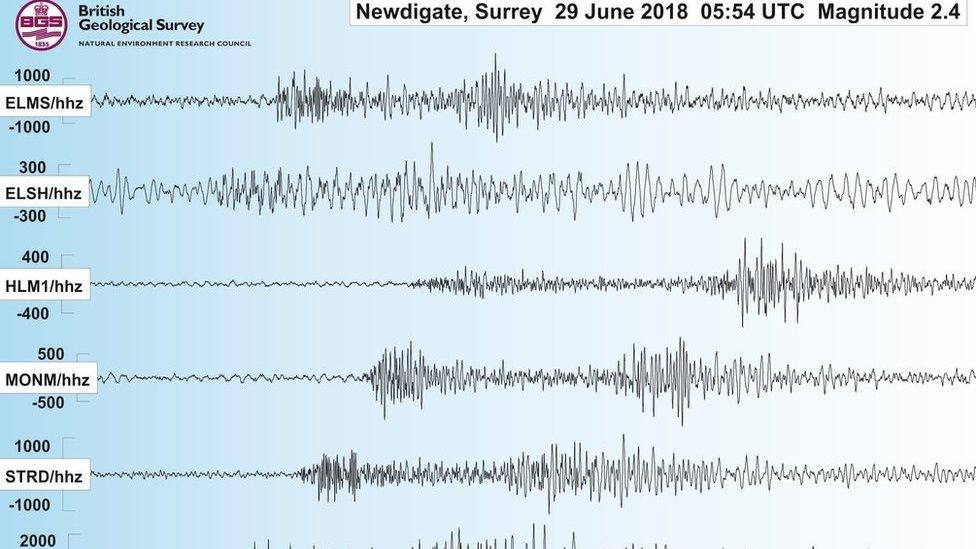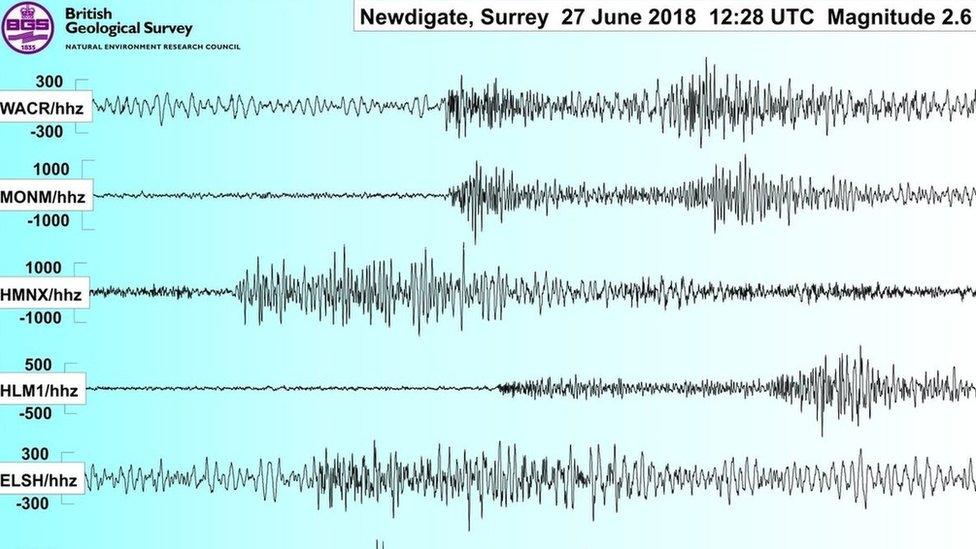Seventh tremor strikes in Surrey 'quake swarm'
- Published

Seven earthquakes have hit Surrey since 1 April
A seventh earthquake in just over 12 weeks has struck in Surrey in what has been described as a "swarm" of tremors.
The quake, which had a magnitude of 3.1, struck at Newdigate, near Gatwick Airport, just before 12:00 BST.
It was the third tremor in nine days and the fourth reported to the British Geological Survey (BGS) since 1 April, but seismologist David Galloway said there had been a total of seven.
The BGS said evidence pointed towards a natural cause.
More than 100 people reported the latest quake to the BGS.
Robin Miller, in Newdigate, said: "The whole place shook. It felt like someone had reversed a vehicle into the building."
The tremor was also felt in Charlwood, Dorking, Reigate and Redhill.

Surrey's earthquake swarm
Three tremors were felt on 1 April. The first had a magnitude of 2.7, a second within minutes came in at 1.8 and the third, an hour later, measured 1.7
The fourth quake on 28 April measured 1.5
The fifth on 27 June measured 2.6
A sixth tremor on 29 June registered 2.4
The latest and biggest quake on 5 July measured 3.0

"With this cluster or swarm, at the moment we put it down to natural seismicity. We live on a dynamic planet," Mr Galloway said.
"Plates move about all the time. They're bashing and moving away from each other."
He said the UK was not on the edge of a plate so did not get hit by huge quakes, but stresses could still affect the rocks.
Allow X content?
This article contains content provided by X. We ask for your permission before anything is loaded, as they may be using cookies and other technologies. You may want to read X’s cookie policy, external and privacy policy, external before accepting. To view this content choose ‘accept and continue’.
Concerns had been raised that test drilling at Horse Hill, external by energy firm UKOG had caused the tremors, but Mr Galloway said the Oil and Gas Authority (OGA) had told the BGS no test drilling had taken place.
The BGS said the calculated epicentres for the earthquakes were about 4.5km (2.7 miles) from the Horse Hill well and scientists took the step of contacting OGA on 28 June.
An OGA spokesman said: "No flow testing operations are currently taking place at the Horse Hill drilling site."
However, Frack Free Sussex has raised concerns about drilling by Angus Energy at Brockham, external, near Dorking.
A spokesman for Angus Energy said: "Angus Energy does not frack nor is there any drilling at Brockham. In fact, there is no fracking in all of Surrey. These fields have been in production for decades, nothing has changed.
"There is absolutely no correlation between the reported tremors and our activities. The British Geological Survey reported the tremors were over seven times deeper and over 11km away from Brockham. Based on the regional geology it would be physically impossible to create these tremors from the Brockham Oil Field. Any contradictory claims are unsupported by the facts or data."
Onshore drilling
In 2011, shale gas drilling in Lancashire was suspended following an earthquake.
Frack Free Sussex spokeswoman Lorraine Inglis said: "It's not just UKOG at Horse Hill, it's also Angus Energy at Brockham."
She said: "We have not had any earthquakes in Surrey or Sussex for 500 years.
"Now we have onshore drilling and we are starting to have earth tremors.
"This one today is higher than the one in Lancashire which led to a moratorium on fracking.
"We want a moratorium on onshore drilling in the Weald."
Friends of the Earth has called for an investigation.
Spokeswoman Brenda Pollack said: "Worryingly, it seems that the authorities can't yet say what has caused these [tremors].
"It's right that a thorough investigation now happens so that people know whether or not it is related to local oil activities."
'Deep-seated fault'
UKOG's executive chairman, Stephen Sanderson, said there had been no subsurface activity at Horse Hill since March 2016.
He said: "We are currently preparing to conduct a flow test using a crane. No flow has yet taken place. We are not drilling and operations utilise a crane not a drill rig.
"We should stress that the work we are planning has the same seismic impact as any type of construction work requiring the use of such a crane."
Mr Sanderson added: "We would also like to point out that there was no recorded seismicity associated with our 2014 drilling and 2016 flow testing, nor are we aware that any of the other 80 plus wells drilled or flowed in the Weald are associated with any seismicity.
"Furthermore as the BGS have stated, the source of this seismicity is related to a deep-seated basement fault at around 5.5km below surface, 4.5km deeper than our activities at Horse Hill."
- Published29 June 2018

- Published27 June 2018
